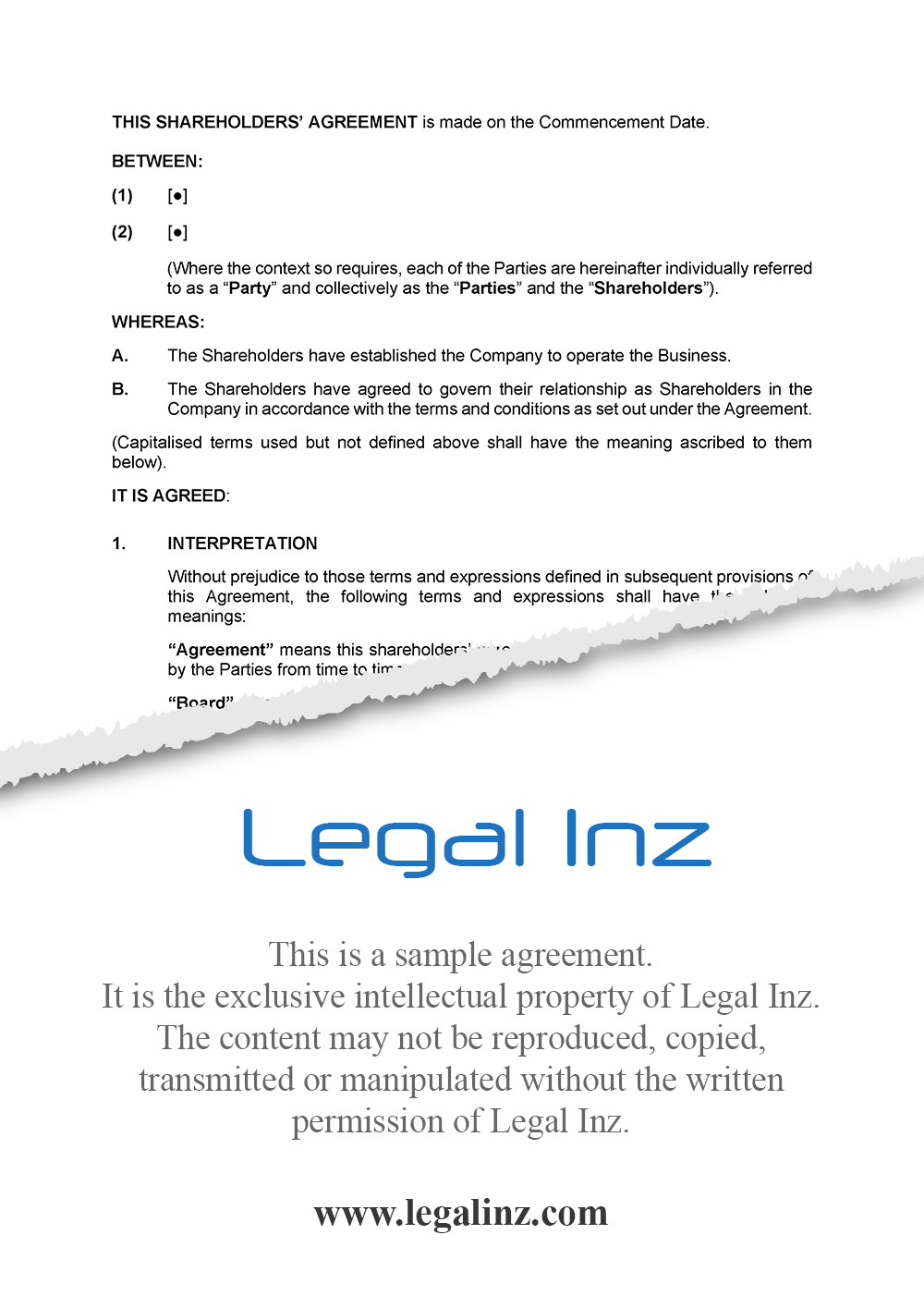A shareholders’ agreement is a legal document which governs the rights and obligations of two or more shareholders of a company. A shareholders’ agreement also outlines the number as well as the proportion of shares that each shareholder would hold in a company. The agreement may further include terms and conditions about the management of the company and other powers that the parties may exercise by virtue of their position as shareholders in the company.
Who is a shareholder?
Any person or entity who owns shares of a company is termed as a shareholder of that company. Shareholders are entitled to certain benefits that arise out of the ownership of shares. Any financial profits, called dividends, that the company makes is in turn divided between all the shareholders of the company in proportion to their shareholding.
Why is there a need to enter into a shareholders’ agreement?
As mentioned above, any shareholder, apart from being the owner of the shares, in turn becomes the owner of the company in proportion to the total number of shares he owns in the company. This attaches certain rights and obligations to the shareholders. Since a company can have more than one shareholder, these shareholders would wish to specifically define their rights and obligations, lay out terms for the management of the company, appointment of directors, decision making, transfer of shares, and other terms such as dividends as well as termination of the company, in order to safeguard their as well as the company’s interests. A shareholders’ agreement, therefore, allows two or more shareholders to agree all these terms through a legal instrument.
What does a shareholders’ agreement cover?
A shareholders’ agreement usually contains the below mentioned terms:
1. Personal information of the parties
It is important to outline the details of the parties who are termed as shareholders under the shareholders’ agreement. The definition would generally include the names, addresses, and email IDs of the parties to the agreement. If any of the parties to the shareholders’ agreement is a corporate entity rather than a person, their trade/commercial license should also be included along with the aforementioned details.
2. Commencement date of the agreement
An agreement should always specify a starting date. This is the date from which the legal relationship between the shareholders would commence.
3. Shareholding details
This clause would specify the total number of shares each shareholder would hold along with their respective shareholding in the company. This is important since many rights that accrue on the shares would be covered in terms of the proportion of shares that a shareholder would hold in the company. A certain number of shares may grant certain associated rights as well as dividends that accrue on such shares.
4. Company and its business
Since it is the shareholding structure of a particular company that form the subject matter of a shareholders’ agreement, it is important to describe the company by its name, details, and the nature of business that the company intends to do.
5. Appointment of the Board and its structure
A shareholder’s agreement should typically have a clause which provides for the appointment of the board of directors, commonly referred to as just the “Board” and the powers of the board. The board is an executive panel which consists of directors who are appointed by the shareholders of a company. The board can be handed important executive decisions to be made for running the company. It is safe to say that the board is responsible for the overall management of a company.
6. Right of first refusal
This is an important clause to be included in a shareholders’ agreement as it protects the interests of the shareholders against any third party purchasing shares of the company. If a shareholder in a company wishes to sell his shares to a third party, the non-selling shareholders in the company should have the right to buy those shares before any third party to whom the shares were offered by the selling shareholder.
7. Rights of Majority and Minority Shareholders
In a shareholders’ agreement, the shareholding structure may not always be equal. There can be instances where one party owns more shares than the other party in the agreement. The party who owns more shares in a company is called a majority shareholder and the party who owns lesser shares in a company is called a minority shareholder. The following are their rights that can be included in a shareholders’ agreement:
(i) Tag Along rights: This is a right which protects the interests of a minority shareholder. If a majority shareholder wishes to sell his shares to a third party, subject to the right of first refusal, the minority shareholder will have the right to “tag along” and require that the third party purchase the minority shareholder’s shares along with the majority shareholder’s shares in the company. If the third party refuses to do so, the sale of shares by the majority shareholder will therefore not be allowed to happen.
(ii) Drag Along rights: This is a right which protects the interests of a majority shareholder. If a majority shareholder receives an offer to buy their shares from a third party, subject to the right of first refusal, the majority shareholder will have the right to require the minority shareholder to dispose of the minority shareholder’s shares as well to the third party. The minority shareholder will then be under an obligation to sell their shares at the same offer price that the third party has offered for the majority shareholder’s shares in the company.
Both of the above provisions can be included in a shareholders’ agreement if the shareholders have mutually agreed to the applicable consequences.
8. Deadlock
This is a common clause in a shareholders’ agreement if there is an equal shareholding structure between the parties. This clause essentially states that if there is a lack of consensus between the shareholders on any of the key decision-making issues under the agreement, then the shareholders will have the right to make a “buy-out” offer. If such an offer is made by a shareholder, the other shareholder can either sell his shares to the offering shareholder or buy the shares of the offering shareholder at the same price.
9. Governing law
This is one of the most important clauses in a shareholders’ agreement as it specifies the law which will govern the agreement. It also outlines the jurisdiction which would govern any disputes if litigation or arbitration is filed in the future. This clause attains even more importance in cases where parties to the agreement are based in different jurisdictions.
10. Additional terms
A shareholders’ agreement could incorporate additional terms such as confidentiality, budgets and financial information, shareholders’ meeting, and termination of agreement to name a few.
The objective of having detailed provisions is to mitigate the risk associated under the shareholders’ agreement. More streamlined clauses and specific terms in an agreement allows the parties to have confidence that theirs rights are duly protected. Our shareholders’ agreement is compliant with applicable UAE law and regulations.
Our online form provides for a range of customisations that cater to all clients on a case-by-case basis. We provide our clients with more freedom and control in terms of what their shareholders’ agreement should cover. Please see our different packages to see various options available to the clients in terms of personal customisation of their shareholders’ agreement.







 verified reviews
verified reviews

